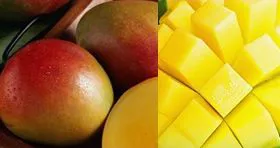 Scientists from Mexico have evaluated the effect of treating the fresh-cut mango ‘Haden’ with ethanolic extract of their seed by-products in the antimicrobial protection and in the antioxidant capacity increase.
Scientists from Mexico have evaluated the effect of treating the fresh-cut mango ‘Haden’ with ethanolic extract of their seed by-products in the antimicrobial protection and in the antioxidant capacity increase.For the study, mangoes were washed with chlorinated water (250 ppm) for 3 min and air dried at 25°C, then they were peeled and the seeds were removed, the pulp was cut into cubes of 2 x 2 cm. Seeds were used for the extraction of phenolic compounds.
A part of cubes were immersed in ethanolic extract for 2 min and dried at room temperature for 30 s (treated fruit). Control and treated cubes were packaged in polypropylene trays and stored at 5°C for 15 days. During storage, phenolic compounds, antioxidant capacity and microbial population (mesophilic aerobic microorganisms, total fungi and yeasts) were measured.
The HPLC analysis of phenolic profile showed that gallic acid was the major identified compound in the ethanolic extract (586.68 mg/g).
Compared to the control cubes, the cubes treated with ethanolic extract showed:
- higher content of total phenolic (7.4 times);
- higher content of flavonoids (3.1 times);
- higher antioxidant capacity, which resulted 2.9, 2.3, and 2.8 times higher when expressed as DPPH, TEAC, and ORAC, respectively;
- a microbial reduction of 80% of mesophilic plate count;
- a microbial reduction of 97% of total moulds.
Source: Vega-Vega V., Silva-Espinoza B.A., Cruz-Valenzuela M.R., Bernal-Mercado A.T., González-Aguilar G.A., Vargas-Arispuro I., Corrales-Maldonado C.G., Ayala-Zavala J.F., 'Antioxidant enrichment and antimicrobial protection of fresh-cut mango applying bioactive extracts from their seeds by-products', Food and Nutrition Sciences, 2013, Vol.4, pagg. 197-203.
